Arte Povera is the last of the artistic movements of the 20th century. These began with the Impressionism, born as a consequence of the advent of photography, capable of directly portraying the image of reality without the need to go through the craftsmanship of the hand, which caused many 20th century artists to wonder whether art would still have a reason to exist. This led to an activity of introspection of art itself, aimed at unearthing the essential and profound reasons for painting and sculpture, thus overcoming the tradition of depiction and the manual as well as mechanical reproduction of the photographic medium. Among the main movements we can name Cubism, Surrealism, Futurism, Expressionism and Abstractionism and Pop Art, of which I have been a part with the Mirror Paintings, created since 1962.

Michelangelo Pistoletto’s Arte Povera collection.
Giuseppe Penone’s 7-metre Tree, 1970, wood, 748 x 20 x 8 cm.
Michelangelo Pistoletto’s house, Turin, 1971.
Photo: Paolo Mussat Sartor.

Giovanni Anselmo, Untitled, 1968,
granite, lettuce, copper wire, sawdust, 90 x 40 x 40 cm.
Photo: Enrico Amici.
The Minus Objects, which constitute a group of works I worked on between the end of ’65 and the beginning of ’66, represent an overcoming of the work of art intended as idea, image and metaphor. The Minus Objects come into existence through an immediate and direct passage from the possible to the existing; each work is created without any cultural, intellectual or formal reference and is produced as a spontaneous genesis without foresight, meditation, relation or verification.
Every object made was not there before, but was possible. It therefore comes into being.
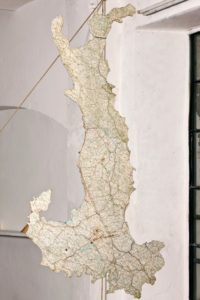
Luciano Fabro, Fascist Italy, 1969,
iron, street map, steel cable, clamp, 146 x 74 x 0.6 cm.
Photo: Enrico Amici.
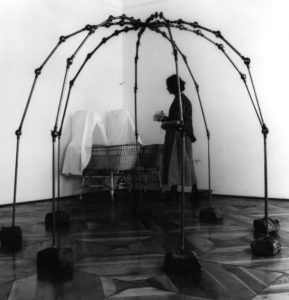
Michelangelo Pistoletto’s Arte Povera collection.
In the foreground, Igloo by Mario Merz, 1969,
brass, clay, 310 cm in diameter, 167 cm in height.
In the background, Maria Pioppi and the cradles of the twins, Armona and Pietra.
Michelangelo Pistoletto’s house, Turin, 1971.
Photo: Paolo Mussat Sartor.
In his Arte Povera manifesto, Germano Celant identifies the matrix of the movement in the Minus Objects. I have found this same essence of being realised in different ways according to the individual disposition of the author in the works of a number of Turin artists active since the early 1970s. Arte Povera does not mean diminishing or detracting, but reaching the essence, understood as the essential. Personally, I have described Arte Povera not only as a minimal expression, but a radical one, referring to the phenomenological root of existence, which from the seed in the earth gives birth to the tree. In the collection of Arte Povera works that I have donated to Cittadellarte – Fondazione Pistoletto, Giuseppe Penone‘s Albero di 7 metri (7-meter Tree) is an example of this: it is not a tree carved in wood, but the tree itself carved and extracted from the inside of a beam. I immediately wanted to acquire the first Arte Povera works, because I felt they were consistent with my thinking. The works exhibited at Cittadellarte – Fondazione Pistoletto in Biella are among the earliest made by the artists Giovanni Anselmo, Luciano Fabro, Mario Merz, Giulio Paolini, Giuseppe Penone and Gilberto Zorio.
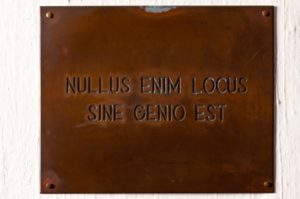
Giulio Paolini, Nullus enim locus sine genio est, 1969,
copper, 22 x 28 x 0.4 cm.
Photo: Enrico Amici.
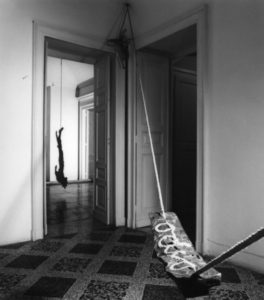
Michelangelo Pistoletto’s Arte Povera collection.
In the foreground, Odio by Gilberto Zorio, 1969,
lead element, 6 x 61 x 14 cm, variable length rope.
In the background, Fascist Italy by Luciano Fabro.
Michelangelo Pistoletto’s house, Turin, 1971.
Photo: Paolo Mussat Sartor.
By Giovanni Anselmo we have a marble sculpture embracing a lettuce, which must be changed almost daily. Then there is an iron parallelepiped on which a slide with the word ‘fading’ is projected and the word ‘fading’ in time fades the metal on which it is projected.
By Luciano Fabro we have L’Italia fascista (Fascist Italy): a political map from the time of fascism, cut out in boot shape and hanging upside down from a noose.
By Mario Merz we have Igloo, built with hydraulic tubes structurally connected according to the numbers of the Fibonacci sequence.
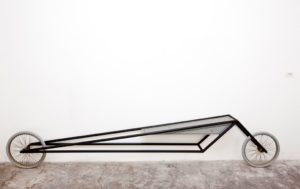
Gianni Piacentino, Amaranth triangle frame vehicle with gray tank, 1970,
enamel on iron, tyre, 340 x 67 cm.
Photo: Enrico Amici.
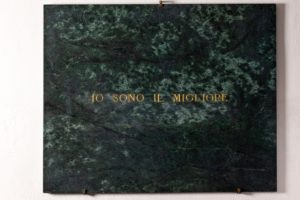
Salvo, Io sono il migliore, 1970, granite, 80 x 100 x 2 cm.
Photo: Enrico Amici.
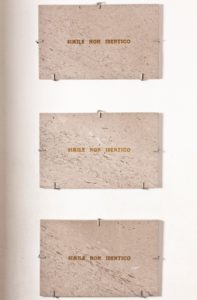
Salvo, Simile non identico, 1970-73,
granite, three elements, 25 x 40 x 2 cm each.
Photo: Enrico Amici.
By Giulio Paolini we have a plaque with the words “Nullus Enim Locus Sine Genio Est” (There is no place without its ‘spirit’) placed in the recess of a door.
By Giuseppe Penone, in addition to Albero di 7 metri, which I have already mentioned, we have Barra d’aria(Bar of Air), a transparent glass parallelepiped which juts out of the window piercing the glass. There is also Svolgere la propria pelle (Unravelling One’s Skin), a photographic emulsion on glass representing the entire surface of the artist’s body in ten squares.
By Gilberto Zorio there is Fluidità radicale (Radical Fluidity), consisting of four photographic images and a lead element that leaves the word “Radical” impressed on the hand when lifting the object. There is also Odio: the word ‘hate’ is formed by a rope hammered into a lead element suspended by the two ends of the rope like a swing.
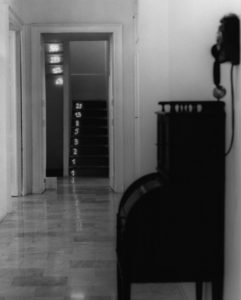
Michelangelo Pistoletto’s Arte Povera collection.
Mario Merz, Fibonacci, 1970,
neon lights, variable dimensions.
Michelangelo Pistoletto’s house, Turin, 1971.
Photo: Paolo Mussat Sartor.
In 1971, the entire flat where we lived, consisting of 350 square metres divided into nine large rooms, in the centre of Turin, was dedicated to this collection. For a few years we shared it with the works, which were the only form of furniture. Merz had also created a work on a staircase inside the flat with the numbers of the Fibonacci sequence, which now only exists in photographic documentation. In the same year, our twin daughters Armona and Pietra were born; their wicker cradles were moved to a different room every day. Besides the collection, in the flat we only had one bed and a large table in the kitchen, around which the art world gathered and where we met our artist friends.They were the same works exhibited here in Biella since 1998. Also on display at Cittadellarte are the works of two artists who were not part of Arte Povera but were working in Turin in the same years and whom I quite appreciated: Gianni Piacentino‘s “bycicle”, i.e. Amaranth triangle frame vehicle with grey tank, and a few marble plaques by Salvo, which bear the inscriptions ‘similar but not identical’, ‘I am the best’, ‘idiot’, ‘eat (oneself) up’, ‘throwing away’.
Text by Michelangelo Pistoletto, edited by Luca Deias
Cover image: Giuseppe Penone, Barra d’aria, 1969, glass, 150 x 12 x 12 cm (photo: Enrico Amici).
Further readings:
– DocBi website
– Article presenting the volume Studi e ricerche sul Biellese.


